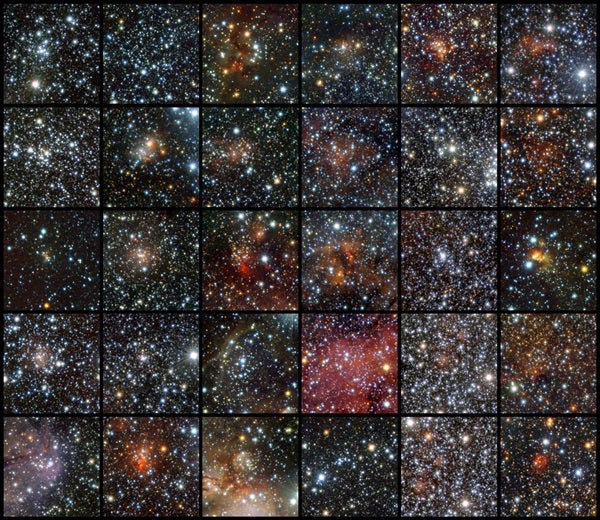This result comes just one year after the start of the VISTA Variables in the Via Lactea program (VVV), one of six public surveys on the new telescope.
“This discovery highlights the potential of VISTA and the VVV survey for finding star clusters, especially those hiding in dusty star-forming regions in the Milky Way’s disk. VVV goes much deeper than other surveys,” said Jura Borissova from the University of Valparaiso in Chile.
The majority of stars with more than half of the mass of our Sun form in groups, called open clusters. These clusters are the building blocks of galaxies and vital for the formation and evolution of galaxies such as our own. However, stellar clusters form in dusty regions that diffuse and absorb most of the visible light that the young stars emit, making them invisible to most sky surveys, but not to the 4.1-meter infrared VISTA telescope.
“In order to trace the youngest star cluster formation, we concentrated our search towards known star-forming areas,” said Dante Minniti from the University of Cincinnati in Ohio. “In regions that looked empty in previous visible-light surveys, the sensitive VISTA infrared detectors uncovered many new objects.”
By using carefully tuned computer software, the team was able to remove the foreground stars appearing in front of each cluster in order to count the genuine cluster members. Afterward, they made visual inspections of the images to measure the cluster sizes, and for the more populous clusters, they made other measurements such as distance, age, and the amount of reddening of their starlight caused by interstellar dust between them and us.
“We found that most of the clusters are very small and only have about 10 to 20 stars,” said Radostin Kurtev from the University of Valparaiso. “Compared to typical open clusters, these are very faint and compact objects — the dust in front of these clusters makes them appear 10,000 to 100 million times fainter in visible light. It’s no wonder they were hidden.”
Since antiquity, only 2,500 open clusters have been found in the Milky Way, but astronomers estimate there might be as many as 30,000 still hiding behind the dust and gas. While bright and large open clusters are easily spotted, this is the first time that so many faint and small clusters have been found at once.
Furthermore, these new 96 open clusters could be only the tip of the iceberg. “We’ve just started to use more sophisticated automatic software to search for less concentrated and older clusters,” said Borissova. “I am confident that many more are coming soon.”
This result comes just one year after the start of the VISTA Variables in the Via Lactea program (VVV), one of six public surveys on the new telescope.
“This discovery highlights the potential of VISTA and the VVV survey for finding star clusters, especially those hiding in dusty star-forming regions in the Milky Way’s disk. VVV goes much deeper than other surveys,” said Jura Borissova from the University of Valparaiso in Chile.
The majority of stars with more than half of the mass of our Sun form in groups, called open clusters. These clusters are the building blocks of galaxies and vital for the formation and evolution of galaxies such as our own. However, stellar clusters form in dusty regions that diffuse and absorb most of the visible light that the young stars emit, making them invisible to most sky surveys, but not to the 4.1-meter infrared VISTA telescope.
“In order to trace the youngest star cluster formation, we concentrated our search towards known star-forming areas,” said Dante Minniti from the University of Cincinnati in Ohio. “In regions that looked empty in previous visible-light surveys, the sensitive VISTA infrared detectors uncovered many new objects.”
By using carefully tuned computer software, the team was able to remove the foreground stars appearing in front of each cluster in order to count the genuine cluster members. Afterward, they made visual inspections of the images to measure the cluster sizes, and for the more populous clusters, they made other measurements such as distance, age, and the amount of reddening of their starlight caused by interstellar dust between them and us.
“We found that most of the clusters are very small and only have about 10 to 20 stars,” said Radostin Kurtev from the University of Valparaiso. “Compared to typical open clusters, these are very faint and compact objects — the dust in front of these clusters makes them appear 10,000 to 100 million times fainter in visible light. It’s no wonder they were hidden.”
Since antiquity, only 2,500 open clusters have been found in the Milky Way, but astronomers estimate there might be as many as 30,000 still hiding behind the dust and gas. While bright and large open clusters are easily spotted, this is the first time that so many faint and small clusters have been found at once.
Furthermore, these new 96 open clusters could be only the tip of the iceberg. “We’ve just started to use more sophisticated automatic software to search for less concentrated and older clusters,” said Borissova. “I am confident that many more are coming soon.”










